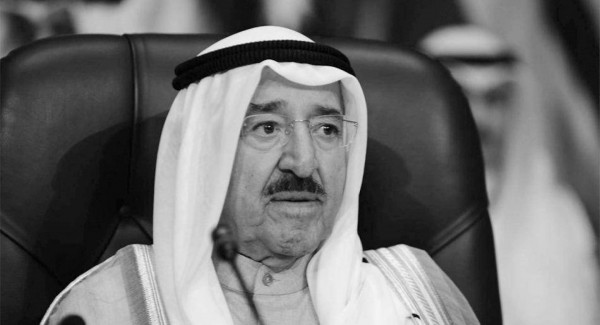Stages from Life of Late Kuwaiti Emir Sabah Al-Ahmad

2020-10-03 - 4:47 p
Bahrain Mirror: Kuwait's Emir Sabah Al-Ahmad Al-Jaber Al-Sabah passed away after a struggle with disease and heart problems. Kuwaiti media cut off their broadcast and began airing recitations from the Holy Qur'an for a while before his death was officially announced.
Sabah Al-Ahmad assumed his post, after conflict within the ruling family over power, and the consent of the then-Crown Prince Saad Al-Abdullah Al-Sabah to abdicate on January 23, 2006, due to his deteriorating health condition. It was reported that he suffered from Alzheimer's disease and was unable to take the oath of office and later died in 2008.
The National Assembly voted to remove Saad Al-Abdullah on January 24, 2006. On 29 of the same month, Sabah Al-Ahmad Al-Jaber Al-Sabah was named as the Emir of the country after difficult negotiations among the Al-Sabah family.
Sheikh Sabah was sworn in after the National Assembly approved his nomination, ending the crisis.
The new Emir was quick to name his half-brother Sheikh Nawaf Al-Ahmad Al-Jaber Al-Sabah as crown prince, and then appointed his nephew Nasser Mohammed Al-Ahmad Al-Sabah, the head of the Emir Court, as the Prime Minister.
The late Emir Sabah Al-Ahmad was born in Al-Jahra in 1929. He is the fourth son of Ahmad Al-Jaber Al-Sabah (Ahmad I). His mother is Munira Othman Al-Saeed Al-Ayyar.
He received his education at Al Mubarakiya School in Kuwait, and then his father sent him abroad to study and gain experience.
The late Emir married Sheikha Fatwa bint Salman Al-Sabah, who died in 1990 after giving birth to four children: Nasser Al-Sabah, Head of the Emir's court, Hamad Al-Sabah, one of the country's top businessmen, Ahmad, who died in 1969, and his only daughter Salwa, who also died in 2002.
In 1955, he became head of the Department of Social and Labor Affairs. He was concerned with social issues. He worked towards providing suitable employment opportunities for citizens, and also organized migrant labor, especially in the post-oil period in Kuwait.
In 1957, he was appointed as head of the Department of Print and Publication. He worked extensively to publish Kuwait Al-Yawam, the state's official gazette, and to issue a law on publications that encouraged political press and guaranteed its freedom within the law.
In 1961, after the independence of Kuwait, the first government was formed and the departments became ministries and he was appointed as Minister of Information. He was also a member of the Constituent Assembly, which was tasked with drafting the constitution.
In 1963, he was appointed as Foreign Minister and Chairman of the Standing Committee for Gulf Aid and remained in the position for 40 years. He became a member of the Kuwaiti National Assembly and was the first to raise the Kuwaiti flag over the United Nations building when they joined in 1963.
As a foreign minister and chairman of the Standing Committee for Gulf Aid, he gave free grants. The parties that received the grants included South Yemen, North Yemen, Oman and South Sudan.
In 1972, he contributed to the conclusion of a peace agreement between the two parts of Yemen to stop the civil war between them.
In 1980, he brokered a successful mediation between Oman and the Republic of Yemen to ease tensions between them.
Prince Sabah suffered from heart problems as he had previously undergone heart surgery that included the fitting of a pacemaker in 2000, and he underwent urinary system surgery in 2007 in the United States.
His half-brother, the late Emir of Kuwait, Jaber Al-Ahmad Al-Sabah, who ruled before him, also suffered from heart problems.
- 2024-05-08Bahrain: One Step Forward, Two Steps Back
- 2024-05-06Ali Haji May Face Imprisonment Again on Charges of "Penetrating a Restricted Area"
- 2024-05-01Was the Resumption of Flights with Iraq Expected?
- 2024-04-20Recent Releases in Bahrain: Something Has Changed
- 2024-04-04Return of Repression to Bahrain's Streets with the Crown Prince and Prime Minister's Blessing